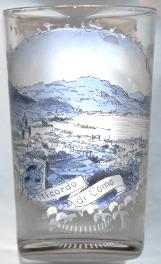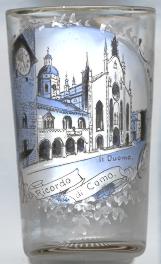

|
| ITALIA | ITALY |
| regione: Lombardia | |
| provincia: Como |
Como is situated at the southwestern tip of Lake Como in northern Italy. The Romans conquered an old Celtic fort at this place in 196 BC
and founded a military settlement, which later became an important Roman city. At the end of the 5th century, the place was conquered by the Goths.
The following centuries were marked by the struggles between the Ostrogoths, the Franks, and the East Roman empire. This period ended with the
victory of the Langobards. Later, Emperor Karl I (Charlemagne) conquered the town. Then, the bishops of Milan
gained the regional power, which was ended by Emperor Friedrich I (Barbarossa) in 1152. The archbishops or Milan again gained the power in 1277,
and from then on the town  was ruled by the Visconti family, later succeeded by the Sforza family. This period was interrupted only by a short period of self-government
between 1447 and 1450, when the town was independent as the Republic of San Abbondio. Under the rule of Milan Como enjoyed economic growth,
especially by the cultivation of mulberry trees and the rearing of silkworms. In the 16th century Como came under Spanish rule, which ended in 1714
when Como became part of the Austrian countries (Lombardy) (see also the map of the Austrian possessions in Italy 1815–1866).
Austria improved the administration of the region, but also imposed a burdensome fiscal policy. After a short period of Napoleonic rule, Como again
became part of the Austrain Lombardo-Venetian Kingdom in 1815.
was ruled by the Visconti family, later succeeded by the Sforza family. This period was interrupted only by a short period of self-government
between 1447 and 1450, when the town was independent as the Republic of San Abbondio. Under the rule of Milan Como enjoyed economic growth,
especially by the cultivation of mulberry trees and the rearing of silkworms. In the 16th century Como came under Spanish rule, which ended in 1714
when Como became part of the Austrian countries (Lombardy) (see also the map of the Austrian possessions in Italy 1815–1866).
Austria improved the administration of the region, but also imposed a burdensome fiscal policy. After a short period of Napoleonic rule, Como again
became part of the Austrain Lombardo-Venetian Kingdom in 1815.
 The Austrian rule ended in 1860 when Como became part of the Kingdom of Italy.
The province of Como, established in 1786 during the Austrian reform of the administration of Lombardy, also included the
territories of Lecco and Varese. During the Napoleonic period it was replaced in 1797 by the
Dipartimento del Lario, but was re-establised after the within the Austrian Kingom of Lombardy-Venetia following the
Congress of Vienna in 1815. Following the unification of Italy it was devided into the provinces
of Como, Lecco and Varese, which, however, were merged again into one single province (Como) in 1926. the province of
Varese was separated in 1927, and the province of Lecco was separated from Como in 1992.
The Austrian rule ended in 1860 when Como became part of the Kingdom of Italy.
The province of Como, established in 1786 during the Austrian reform of the administration of Lombardy, also included the
territories of Lecco and Varese. During the Napoleonic period it was replaced in 1797 by the
Dipartimento del Lario, but was re-establised after the within the Austrian Kingom of Lombardy-Venetia following the
Congress of Vienna in 1815. Following the unification of Italy it was devided into the provinces
of Como, Lecco and Varese, which, however, were merged again into one single province (Como) in 1926. the province of
Varese was separated in 1927, and the province of Lecco was separated from Como in 1992.
The famous
(see also list of other basilicae minores depicted on glasses of this collection)
 cathedral Santa Maria Assunta (Assumption of Our Lady) [right]
was begun in 1396 above the remains of the ancient Romanesque basilica of Santa Maria Maggiore, which had been built in the 11th century.
The construction of the new cathedral lasted until 1740 so that the church shows Late Gothic, Renaissance and Baroque parts.
The Gothic façade dates from 1455 and holds two statues of the Latin writers Pliny (Plinius) the Elder and Pliny the Younger who both were
born in Como (in 23 and ca. 61 AD, respectively). the nave dates from the Late Gothic period, the presbytery and the dome are from the Baroque period.
The dome is 75 m high and was constructed in 1731–1740.
The cathedral received the papal title of a Basilica minor in 1951.
cathedral Santa Maria Assunta (Assumption of Our Lady) [right]
was begun in 1396 above the remains of the ancient Romanesque basilica of Santa Maria Maggiore, which had been built in the 11th century.
The construction of the new cathedral lasted until 1740 so that the church shows Late Gothic, Renaissance and Baroque parts.
The Gothic façade dates from 1455 and holds two statues of the Latin writers Pliny (Plinius) the Elder and Pliny the Younger who both were
born in Como (in 23 and ca. 61 AD, respectively). the nave dates from the Late Gothic period, the presbytery and the dome are from the Baroque period.
The dome is 75 m high and was constructed in 1731–1740.
The cathedral received the papal title of a Basilica minor in 1951.
[https://de.wikipedia.org/wiki/Como, https://en.wikipedia.org/wiki/Como;
https://it.wikipedia.org/wiki/Provincia_di_Como, https://it.wikipedia.org/wiki/Dipartimento_del_Lario_(1797)]
![[scale]](lineal.jpg)